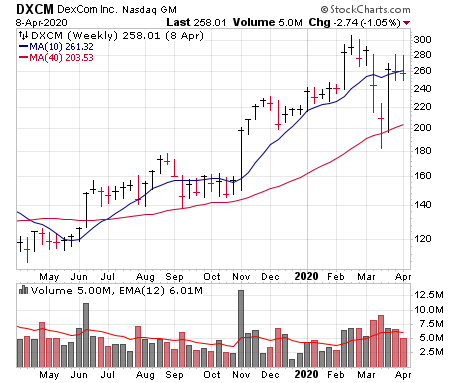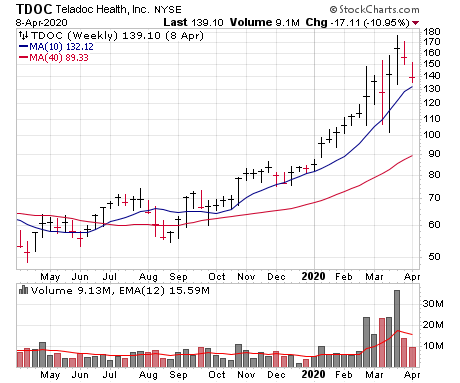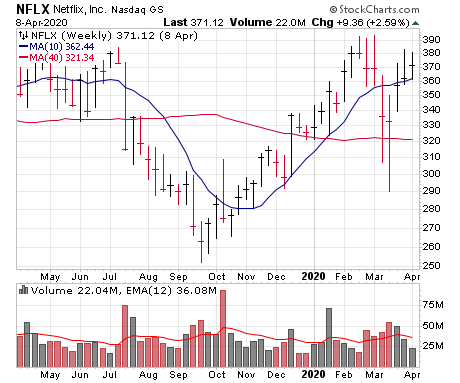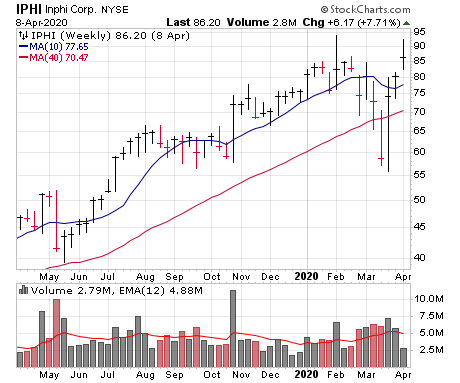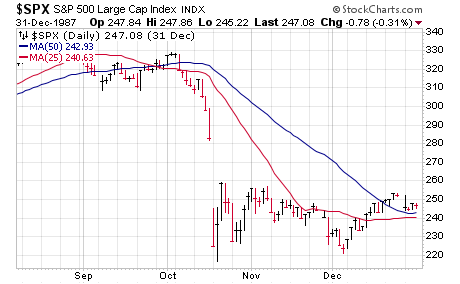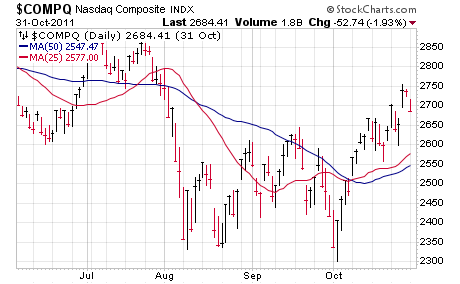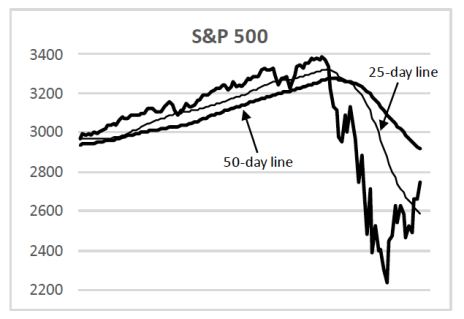The market has done about as good a job as could be expected rebounding off its March 23 low, and that makes for an interesting setup next week: If the major indexes can continue to strengthen, we could get a Tides buy signal, and that could also coincide with some bullish blastoff signals, too. To this point, though, the trends have yet to turn up, so we advise a defensive stance -- but we’re certainly keeping our eyes peeled for further unusual strength.
Cabot Growth Investor 1443
[premium_html_toc post_id="202421"]
Key Test for the Market Coming Up
In the last issue, we wrote about some shorter-term signs of spring that had finally popped up for the market, including an encouraging positive divergence from the broad market as stocks collapsed. Throw in some horrid sentiment and a nice initial pop off the lows, and it looked like the market had finally found a workable low on March 23.
That view has held up well since; while there have been some ups and downs, countless BIG FONT headlines and (especially this week) some rotation out of resilient names and into beaten-down sectors, the market in general has staged a solid bounce, which nobody is complaining about.
To this point, though, the rebound hasn’t changed any of the primary evidence. Both our Cabot Tides and Cabot Trend Lines remain negative, and while there remain many good-looking growth stocks, almost none are galloping ahead. (A total of 25 stocks hit new highs today, which isn’t surprising, but tells you nothing much is letting loose on the upside.) That’s why we’ve stuck with an overall defensive stance.
Still, it looks like the market is set up for a key test in the days ahead, so later in this issue, we review some past “bounces” to see what’s normal and not. And it turns out today’s environment is fast approaching some vital areas. More important, our own Cabot Tides are on watch for a green light next week; some further upside from the major indexes could flip the intermediate-term trend up.
Another potential positive is that we’re starting to see some blastoff indicators potentially speak up—one shorter-term one flashed right off the lows, and another one could do the same next week if the buyers continue to do work. Neither is as reliable as our 2-to-1 and 90% Blastoff Indicators (those two have pristine track records, yet take a bit more time to flash), but they’re a plus nevertheless.
Of course, with the trends pointed down, there’s still a good chance this rally will fail, so if you’re stuck with some broken stocks you wish you didn’t own (it happens to everyone), it’s probably a good time to use the bounce and start piecing out of them. But, on the flip side, it’s important to have your shopping list ready should the buying pressures accelerate.
What To Do Now
In other words, now’s the time to form a game plan. For us, that means remaining defensive until more legitimate bullish evidence emerges—tonight, we have no changes, as the Model Portfolio remains solidly in the black for the year. If the rally fails, we’ll obviously stay in our bunker, but should the Tides turn positive, we’ll aim to put a chunk of money to work. Stay tuned.
Model Portfolio Update
One of the surprising things of the past three weeks is the huge number of buying-related questions we’ve gotten. Of course, there are no bad questions, and we’ve written repeatedly that a small buy or two if you’re already heavily defensive is fine. But the “buy low” and “get in early” urge that emerges in a downtrend usually isn’t your best guide.
Part of that is math—when volatility is high and stocks are down, it’s relatively easier to suffer big losses in the market or individual stocks. Moreover, the risk-reward of buying in a downtrend isn’t great; yes, you might make a few nickels here or there, but one mistake can easily wipe that out, and there’s no use setting your portfolio back further before the big money opportunities arise down the road.
Another reason to stay mostly out is because downtrends are inherently rotational and divergent. We’ve seen that this week—as the major indexes have rallied, stocks that had been holding up well have actually pulled in while money chases the beaten-down (financials, industrials) areas that appear “low.” Simply put, when the under-the-surface action is helter-skelter, it’s usually best to keep it light.
Looking ahead, though, some real sunshine could be breaking through, though as we wrote above, next week will be telling. In the portfolio, we were tempted to add a half-sized position or two earlier this week, but we backed off when growth stocks showed slippage; we’re still holding 70% in cash. From here, the game plan is simple: If our Cabot Tides can turn positive in the days ahead, we’ll slowly start to put money to work, likely investing 15% to 25% of the portfolio depending on what individual growth stocks are doing. (A lot of powerful action and breakouts = putting more money to work.) And from there, we’ll just go with the flow, adding more if we develop profits … but holding off if the rally runs into the trouble.
On the flip side, if there’s no buy signal and the market and growth stocks start to fall apart again, we could actually build up more cash. We’re not anxious to go in that direction, but we will if we have to. Tonight, though, we’re more optimistic than not, and we’ll be on the horn if we have any changes. For now, we’ll again stand pat and let the market prove itself on the upside.
Current Recommendations
| Stock | No. of Shares | Portfolio Weightings | Price Bought | Date Bought | Price on 4/09/20 | Profit | Rating |
| Dexcom (DXCM) | 386 | 7% | 216 | 11/15/19 | 275 | 28% | Hold |
| DocuSign (DOCU) | 1,310 | 9% | 65 | 9/13/19 | 91 | 39% | Hold |
| Teladoc (TDOC) | 631 | 7% | 78 | 11/01/19 | 146 | 87% | Hold |
| Vertex Pharmaceuticals (VRTX) | 414 | 8% | 199 | 11/8/19 | 247 | 24% | Hold |
| CASH | $945,933 | 70% |
Dexcom (DXCM 275)—DXCM has hit a little indigestion along with most resilient stocks this week, but that doesn’t change its overall picture—the stock recouped 80% of its February-March decline and even with some slippage is still hanging above its 50-day line (now around 257), which is relatively rare air. Aside from a post on its website that said its supply chain is intact, the company has been all quiet on the news front. In this environment, no news is probably good news, though the next big event will be April 28, when the company will report Q1 results and (more importantly) give an update on what management sees in terms of the rest of the year, especially when it comes to some of the newer initiatives that were set to kick into gear in 2020 (G6 launch with Medicare, greater penetration into the Type 2 diabetic market, etc.). Possibly reflecting some caution, analysts have trimmed this year’s estimates (they’re now looking for 12% earnings growth, though 2021 estimates remain strong at +42%), though Dexcom has a history of trouncing those figures. We’ll see how it goes, but DXCM still has a bullish combination of a great story, excellent numbers and a resilient chart that should propel it forward once the market decisively gets going. HOLD
.
DocuSign (DOCU 91)—Yes, the current global shut-in is boosting the fortunes of companies that benefit from more people watching, playing or (for DocuSign) working from home. But beyond that, we think recent events could change behavior for a long time—work has been becoming more digital and virtual for a while, and with companies literally running their business out of people’s homes for the past three weeks, we think there’s little chance they fully go back to the old ways, even when economies are reopened. That should mean even more sustained demand not just for DocuSign’s core e-signature solution (most of the initial papers of our recent mortgage refinancing were e-signed with this firm’s solution) but its so-called agreement cloud, which allows clients to automate other steps of the process (document prep, follow-up measures, etc.). All in all, analysts see the company’s earnings lifting north of 60% both this year and next, a growth profile that’s nearly impossible to find these days. As for the stock, DOCU was one of the few that took a hit during the crash but rebounded all the way back to new high ground last week. Of course, in market downtrends, strength is usually sold into, so DOCU’s quick drop back into the middle of its prior consolidation wasn’t a shock. But shares have perked up again this week, and big picture, the firm’s rare combination of rapid, reliable growth, along with a stock that hasn’t been overplayed (initial kickoff came last Labor Day) bodes well. If you own some, sit tight—and if you want to nibble around here, we’re OK with that, too. HOLD.
Teladoc (TDOC 146)—We’ve written a few times that when virus fears recede, it’s likely some of the hottest names like TDOC would pull in, possibly sharply, as money moved to other areas; that’s a big reason why we trimmed our position three times, and are currently sitting with about 40% of our original position. (It’s still a fair-sized position overall because of the stock’s big run-up.) Still, despite the recent selling, we actually think the stock is handling itself very well, basically falling back to where it was two weeks ago and still north of its rising 50-day line (near 130), and we’re determined to give our remaining position plenty of room to consolidate before resuming its advance. One analyst report this week highlighted Teladoc’s opportunity, believing the firm “hosted” 1.7 million visits in Q1 (200,000 more than guidance), which will boost revenues. But far larger than that is the opportunity going forward. When the company gave an update in mid-March (when visit volume was going through the roof), it said half of visits were from first-time users, and it’s likely that far more employer and health plan offerings will incorporate telehealth services going forward. (While Teladoc serviced 56 million members at year-end, there’s another 73 million potential users just at existing clients, not to mention 190 million more elsewhere—and that’s just in the U.S.!) Long story short, 2020 is likely to be telehealth’s breakout year, so if management makes the right moves, Teladoc has blue chip written all over it. A total meltdown from the stock would have us taking action, of course, but we’re content to practice patience as it digests its gains. HOLD.
Vertex Pharmaceuticals (VRTX 247)—VRTX was the second of our stocks (along with DOCU) to actually rally to a new high in recent days—and similarly, shares have backed off since then, which is actually quite normal in these types of environments. Still, while there are no sure things, we’d be surprised if the buyers didn’t step in relatively soon, as Vertex is one of the few companies that has come out and said (a couple of times) that its core business (cystic fibrosis treatments, especially Trikafta, which expanded the company’s addressable market to 90% of CF patients, up from 60% previously) has been unaffected by the virus shut-in, which effectively means Vertex’s huge growth projections—earnings are expected to rise from $5.33 per share last year to north of $10 in 2021 and $12 in 2022—are intact. Like most biotechs, Vertex also has more than a few irons in the fire for future drugs, covering many diseases, but the firm’s CF treatments are what big investors are focusing on today. Don’t forget, too, that VRTX itself just got going from a two-year dead period back in October, so this is far from a later-stage situation. Earnings are likely out in late April or early May, which will be key, but we remain optimistic VRTX has a bright future, and big investors agree, as many top-performing mutual funds own sizable positions. If you own some, hang on. HOLD.
Watch List
- Chewy (CHWY 43): CHWY had a bit of post-earnings indigestion but it’s quickly popped back toward new highs, and we remain very high on this story. Yes, it’s benefiting from the shut-in (more online buying of everything), but the company has a huge future as the Amazon of pet supplies. Analysts see revenues surging 31% this year, and we think years of 20%-ish growth are likely as purchases of pet supplies shift to online, with Chewy being the biggest beneficiary.
- Cloudflare (NET 21): NET has pulled in over the past few days along with many growth stocks, but it remains in fine shape (above key moving averages, etc.). We continue to think Cloudflare has the look and feel of a fresh leader that big investors will build positions in. Earnings are due out May 7.
- Inphi (IPHI 87): Inphi looks like one of those rare situations with a good long-term story, solid demand today despite (and maybe because of) the shut-in and the prospects of even faster growth once the world turns right side up. See more below.
- Netflix (NFLX 371): NFLX isn’t a new story to anyone, but the stock has a history of taking a year or two off (usually when costs ramp up) and then resuming its overall run as growth reaccelerates, and we think one of those fresh uplegs could start soon. See more below.
- Okta (OKTA 131): We rode OKTA to solid gains before it went over the falls last fall and again with the market recently. But it’s rebounded very well during the past three weeks and it has one of the best new-age cybersecurity stories and excellent sponsorship.
- Seattle Genetics (SGEN 120): SGEN looks like one of the next big oncology franchises, with one blockbuster already on the market and another one or two likely to kick in soon. The stock roared all the way back to new highs before backing off this week.
Other Stocks of Interest
Netflix (NFLX 371)—We’re obviously more interested in newer, fresher potential leaders, but there are usually a couple of big-cap growth leaders that help lead any new market upturn, and Netflix looks to be in pole position in terms of that category. Everyone knows the story, so we won’t delve into that; it’s obviously the leader in digital streaming, with decent growth in the U.S. and faster growth overseas. At the end of last year, the company had 167 million paid subscribers, up 20% from a year ago. While there aren’t any details yet, the global shut-in has likely helped business, and after a tough three quarters as costs ramped up (as they occasionally do at the company), sales (up 31% each of the past two quarters) and earnings (up 65% and 333%) have ratcheted up of late, and analysts see that continuing—in fact, Netflix is one of the few firms that’s expected to grow its bottom line more than 40% both this year and next. Thus, the overall story remains the same as it has in recent years, and growth is reaccelerating after a slow patch. And, just as important, the long- and short-term charts look enticing: Long-term, NFLX is near the top of a 21-month consolidation (it peaked back in the summer of 2018), and more recently, the stock found big-volume support during the worst of the crash (closing mid-range both weeks) and has quickly snapped back toward its highs. As mentioned above, the bigger money will probably be made in fresher names, but we think NFLX is poised for a healthy run during the next sustained market uptrend. Earnings are due out April 21.
Inphi (IPHI 87)—If you’re a big investor, you’re digging to find companies that have solid growth stories, have businesses that will at least hold up well (if not continue to grow) during this self-induced recession, and most important, have great prospects once economies begin to re-open for business. Inphi—the leading provider of high-speed data interconnects—is one of the few firms that checks all of those boxes. The story has been solid for a few quarters, as intra-datacenter connectivity is being upgraded (especially among hyperscale customers like Amazon, Google, Alibaba, Facebook and others; Inphi has a dominant market share in this business) and the firm is benefiting from the 5G networking buildout and connections between data centers (thanks to a big partnership with Microsoft), too. When the global shut-in began, most thought corporate spending would vanish, but as it turns out everyone working/playing/learning from home has actually boosted network demand. And looking beyond the next couple of months, the company remains a step or two ahead of its competitors, already working on a next-generation 400G platform and even sampling a next-next-generation 800G platform for down the road. Obviously, there’s uncertainty in every business, but it appears not even a global pandemic is enough to derail the need for speed on networks around the world; analysts see revenues up 20%-plus both this year and next, with earnings up 35% this year and another 50% next. We made decent money on the stock from last summer through February, but sold our remaining shares when IPHI broke down with the market and it skidded after that. But the action since the market’s March 23 low has been awesome—IPHI immediately recouped most of its decline in just a few days, and this week, it’s registered new closing highs. Given that it broke out from a multi-year base last summer, IPHI looks ready to resume its run should the market turn positive.
Zscaler (ZS 63)—One of our (and the market’s) favorite themes in the first half of last year was the new-age cybersecurity companies that were eating the old guard’s lunch thanks to (a) a more mobile workforce and (b) the movement of apps to the cloud that made all the old firewalls, virtual private networks and whatnot increasingly obsolete. Okta remains one our favorites in this field (the leader in Identity), but Zscaler is another one that’s come onto the scene and is showing very intriguing strength of late. The details of its offering are a bit tech-heavy, but the bottom line is that instead of having a networking mess on their hands, firms that sign up have all of their traffic (whether it’s someone on the road or in the office) run through the Zscaler cloud platform, allowing users to access apps and private information seamlessly and with all of the security they used to have protecting their headquarters. Not only is the security better, but it results in cost savings as firms ditch old, expensive, on-premise solutions. It’s been a hit, with the company’s revenues advancing between 50% and 59% each of the past four years, and while that is expected to slow (analysts see the top line up 37% in 2020), the stay-at-home reality of today is likely to reignite demand. To be fair, ZS stock took a huge hit late last year after billings looked iffy for a quarter or two, but we’re putting much more weight on the recent action. After diving to a new low in March, the stock catapulted back to its February highs (not many stocks can say that) and has actually tightened up of late, which is very rare. There’s still old overhead, but it’s looking like the rough days for ZS are over and the path of least resistance could be turning up.
What is “Normal” for a Bounce?
Let us first say that, as students of market history, we’re usually pretty big fans of using precedent analysis to gain insight into what the market may or may not do—because human nature never changes, similar patterns repeatedly play out over the decades, so understanding the past is frequently a help (both in the market, and in life).
Admittedly, this time around, the situation is a bit unique; there simply haven’t been past examples of worldwide forced recessions due to a pandemic. Even so, we have seen many crash-type environments, and by looking at some we can get an idea as to what kind of upmove is normal for a bounce … and what sort of strength might be telling us the market is abnormally (in a good way) strong. Let’s run through three examples and see what insight they can give us.
First, take a gander at 1998, when the market imploded due to global currency issues and (eventually) the blow-up of Long Term Capital Management, all of which had everyone predicting a sharp recession; the Nasdaq’s first leg down saw it lose nearly 28% into late August. From there, the Nasdaq recouped 53% of its decline, but bumped into its declining 50-day line and our Cabot Tides never turned positive. It then retested (undercut) its low a couple of weeks later before getting going for good.
Second is the 1987 crash, which might be the most similar to the current environment—from its early-October peak, the S&P 500 imploded 34% in a matter of days. Interestingly, the bounce was pretty pathetic; the S&P recouped just 38% of its crash, couldn’t get anywhere close to its 50-day line and, of course, the Tides never turned positive. The retest came in early December before a choppy advance developed over the following year.
Last, let’s look at 2011, which saw the Nasdaq fall 20% in just over two weeks. The action after that was incredibly volatile, but the bounce before the retest (in August and early September) recouped 55% of the decline, ran into resistance near the falling 50-day line and, again, the Tides never turned positive.
Obviously, there are a bunch of other examples we could go through, but looking at these and other waterfall-like declines, we find that a pre-retest bounce often will see the major indexes recoup 40% to 55% of their prior declines. However, it’s rare (not impossible) for the Tides to turn positive during the bounce phase, and the 50-day line often provides resistance.
What does this history lesson mean for today? Basically it means if the market can exceed the above metrics, it would be telling us this rebound is something unique—and what’s interesting is we’re fast approaching some of these key areas. if the S&P 500, say, recoups more than 55% of its crash decline (above 2,860 or so), exceeds its 50-day line (near 2,900 and falling) and our Tides turn green, it would be a clue that there might not be a retest. Obviously, there are no exacts when it comes to these guidelines, but these are metrics we’ll be watching in the days to come.
Will Blastoff Indicators Point the Way?
In addition to the above factors, one thing we’d expect to see should the market break the “normal” pattern would be some blastoff indicators flashing—that’s exactly what happened during the late 2018 V-bottom when stocks immediately took off on the upside.
To this point, the key indicators we watch—such as the 2-to-1 (which flashed January 9, 2019) and 90% Blastoff measures (February 20)—haven’t come close to flashing. Interestingly, though, one (very) early indicator has, and there’s another that bears watching into early next week.
The one that did flash occurred right off the March 23 market low: The percent of all stocks above their 10-day moving average rose from below 10% to above 90%. Interestingly, despite it obviously being a very short-term indicator, it has solid longer-term results—during the past 38 years, there have been 33 of these signals, and the market was higher a year later 32 of those times, for an average gain of 15.6%.
Another one to watch is a cousin to the 2-to-1 Blastoff Indicator, except it can occur in just five days. Invented by Walt Whaley, it looks at the five-day advance-decline breadth on the NYSE; if the five-day ratio is 2.8-to-1 or more, it represents a very rare thrust that has historically led to 20%-plus gains when looking out the next year.
The Whaley thrust bears watching right now; the rally that began on Monday has shown some excellent breadth statistics. It’s a very high bar to cross, but if the final numbers today and next Monday (market is closed Friday) impress, it’s possible it could trigger.
To be clear, neither of these are quite as reliable as the two blastoff measures we follow, as they sometimes trigger early (meaning the market has some rough stretches before getting going). Nevertheless, the more of these relatively rare measures that trigger, the better the odds that the market’s next major move is up.
Cabot Market Timing Indicators
The market has done a solid job of bouncing off its March 23 panic low over the past three weeks, but a key juncture is coming next week; if the major indexes and leading stocks can extend their gains, the intermediate-term trend could turn up, but the onus remains on the bulls to make that happen.
Cabot Trend Lines: Bearish
Our Cabot Trend Lines have obviously improved a lot this week, but even after today’s rally, both the S&P 500 (by 7.3%) and Nasdaq (by 2.3%) stand clearly below their respective 35-week moving averages. We’re open to any scenario going forward, but we’ll need to see much more strength before the market’s longer-term trend can return to bullish territory.
Cabot Tides: Bearish
Our Cabot Tides has shown some improvement—all five indexes we track (including the S&P 500, daily chart shown here) have leapt back above their lower (25-day) moving averages, though those moving averages are still trending down. That sets up an important test next week: If the S&P and other indexes can continue building on their gains, a Tides green light could come sometimes next week. We’ll be watching closely, but until proven otherwise, the intermediate-term trend is pointed down.
Cabot Real Money Index: Positive
The Real Money Index plunged two weeks ago to its lowest (most positive) level since December 2018, as nearly $100 billion of money was pulled out of equity funds and ETFs over a five-week period. Thus, investor (and man-on-the-street) panic is widespread, which will play into the bulls’ hands longer term. As we’ve been writing, there will be good money to be made during the next sustained uptrend—but the key is practicing patience until the turn comes.
Charts courtesy of StockCharts.com
The next Cabot Growth Investor issue will be published on April 23, 2020.
Cabot Wealth Network
Publishing independent investment advice since 1970.
CEO & Chief Investment Strategist: Timothy Lutts
President & Publisher: Ed Coburn
176 North Street, PO Box 2049, Salem, MA 01970 USA
800-326-8826 | support@cabotwealth.com | CabotWealth.com
Copyright © 2020. All rights reserved. Copying or electronic transmission of this information is a violation of copyright law. For the protection of our subscribers, copyright violations will result in immediate termination of all subscriptions without refund. No Conflicts: Cabot Wealth Network exists to serve you, our readers. We derive 100% of our revenue, or close to it, from selling subscriptions to its publications. Neither Cabot Wealth Network nor our employees are compensated in any way by the companies whose stocks we recommend or providers of associated financial services. Disclaimer: Sources of information are believed to be reliable but they are not guaranteed to be complete or error-free. Recommendations, opinions or suggestions are given with the understanding that subscribers acting on information assume all risks involved. Buy/Sell Recommendations: All recommendations are made in regular issues or email alerts or updates and posted on the private subscriber web page. Performance: The performance of this portfolio is determined using the midpoint of the high and low on the day following the recommendation. Cabot’s policy is to sell any stock that shows a loss of 20% in a bull market or 15% in a bear market from the original purchase price, calculated using the current closing price. Subscribers should apply loss limits based on their own personal purchase prices.

